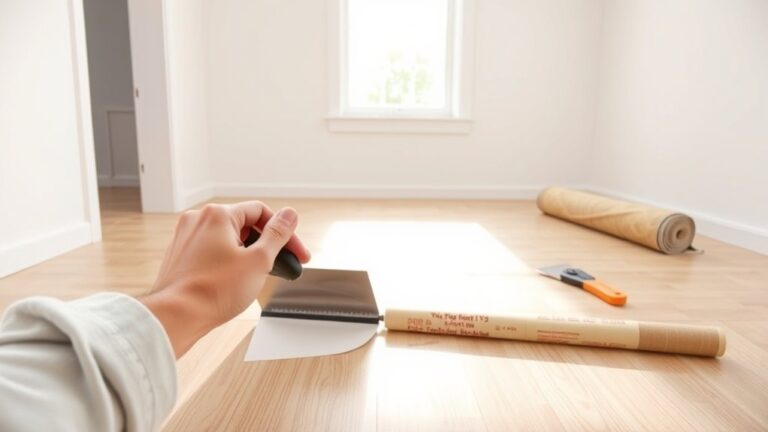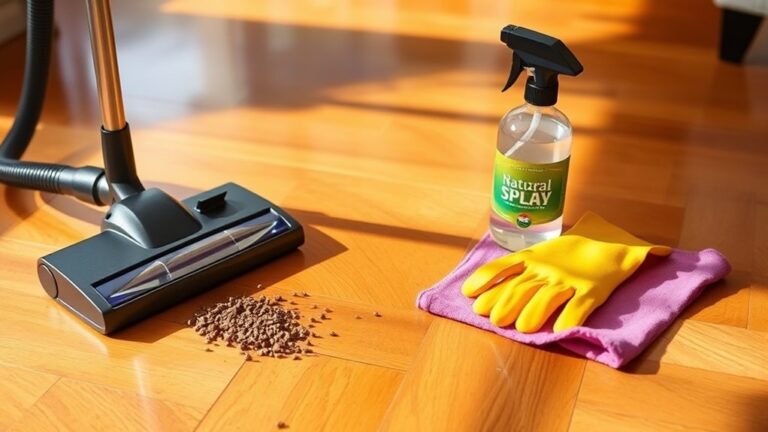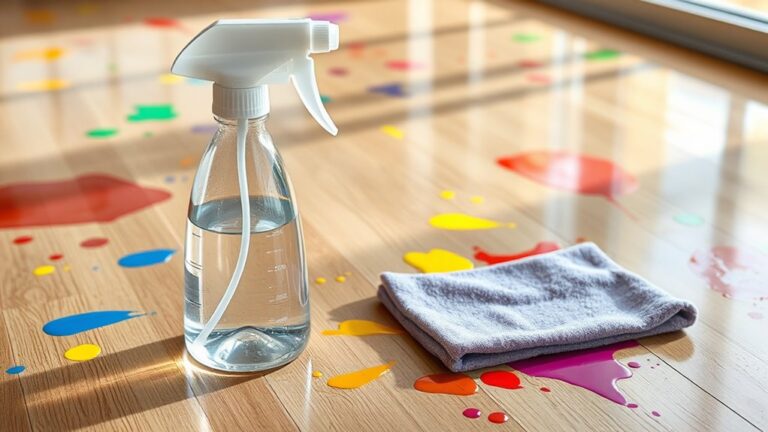To get urine out of wood floors, first assess the damage and gather cleaning supplies like gloves, paper towels, and enzyme-based cleaner. Blot up any excess urine immediately without rubbing, then clean the area with a mild detergent. Apply an enzyme-based cleaner to break down organic matter, rinse, and dry thoroughly. Neutralize odors by sprinkling baking soda and polishing to protect the wood. Following these steps guarantees effective removal and prevents lasting damage—exploring more methods will enhance your results.
Assess the Damage and Gather Supplies

Before you begin cleaning, you’ll need to carefully assess the extent of the urine damage on your wood floors to determine the appropriate treatment. Start by inspecting discoloration, warping, or soft spots indicating deeper penetration. This damage assessment guides whether surface cleaning suffices or if sanding and refinishing are necessary. Next, assemble a supply checklist: gloves, paper towels, a gentle wood cleaner, white vinegar, baking soda, enzyme cleaner, soft cloths, and a spray bottle. Having these ready prevents interruptions and guarantees efficient treatment. Accurate damage assessment combined with a complete supply checklist empowers you to tackle the problem decisively, preserving your wood floors’ integrity and your freedom from prolonged cleanup hassles.
Blot Up Excess Urine Immediately
You need to act quickly to prevent urine from penetrating deeper into the wood. Use absorbent materials like paper towels or a clean cloth to blot the area without rubbing, which can spread the stain. This immediate step is essential to minimizing damage and easing the cleaning process.
Act Quickly to Prevent
Although it may seem minor at first, blotting up excess urine immediately is essential to prevent stains and damage to your wood floors. Your quick response is vital for effective cleanup and maintaining your floor’s integrity. Here are key prevention tips to act fast:
- Grab a clean, dry cloth or paper towels to absorb as much liquid as possible without rubbing.
- Avoid spreading the urine by blotting gently instead of wiping.
- Work from the outside edges toward the center to contain the spill.
- Dispose of soiled materials promptly to prevent lingering odors.
Use Absorbent Materials
When urine hits your wood sol, acting quickly with absorbent materials is essential to minimize damage. Grab clean, dry cloths, paper towels, or microfiber towels and press them firmly onto the affected area. This immediate action draws up excess liquid, reducing the chance of urine stains penetrating deep into the wood grain. Don’t wipe or rub—that can spread the urine further. Instead, gently blot to soak up as much moisture as possible. Using absorbent materials right away helps prevent discoloration and lingering odors. Keep replacing damp towels with dry ones until no more urine transfers. This step buys you the freedom to proceed confidently with deeper cleaning, knowing you’ve effectively limited the urine’s impact on your wood floor’s surface and finish.
Avoid Rubbing or Spreading
One essential step in dealing with urine on wood floors is to avoid rubbing or spreading the liquid. Rubbing can push urine deeper into the wood grain, increasing the risk of stains and odors. Instead, focus on blotting techniques that prioritize preventing damage and effective cleaning techniques. Here’s how to proceed:
- Use a clean, absorbent cloth or paper towel to gently press on the urine spot.
- Avoid scrubbing; blot repeatedly, replacing the cloth as it saturates.
- Work from the outer edge toward the center to contain the spill.
- Dispose of used materials promptly to prevent re-contamination.
Clean the Area With a Mild Detergent
You’ll want to pick a gentle detergent specifically formulated for wood floors to avoid damaging the finish. Always dilute the cleaner according to the manufacturer’s instructions to prevent residue buildup or discoloration. Cleaning this way guarantees the area is sanitized without compromising the wood’s integrity.
Choose Gentle Cleaning Agents
Although harsh chemicals might seem effective, they can damage your wood floors and worsen stains. Opt for gentle cleaning agents that maintain the wood’s integrity and preserve its finish. Look for products or homemade solutions that:
- Use natural alternatives like diluted vinegar or castile soap, which respect the wood’s pH balance
- Avoid ammonia, bleach, or abrasive cleaners that strip protective coatings
- Are free from harsh fragrances and dyes that can embed in the wood grain
- Provide effective cleaning without harsh chemicals to keep the floor safe and odor-free
Proper Dilution Ratios
A proper dilution ratio is critical when cleaning urine from wood floors to prevent damage while effectively removing stains and odors. You need to master dilution techniques that balance potency and gentleness. Typically, a mild detergent should be diluted at a ratio of about one teaspoon per quart of warm water. This cleaning ratio guarantees the solution is strong enough to lift urine residues without stripping the wood’s finish or causing warping. Avoid overly concentrated mixtures that can leave residues or weaken the wood fibers. Always mix thoroughly and test the solution on a small, inconspicuous area first. By adhering to precise dilution techniques and cleaning ratios, you maintain the floor’s integrity and extend its lifespan, freeing you from costly repairs or refinishing.
Apply an Enzyme-Based Cleaner
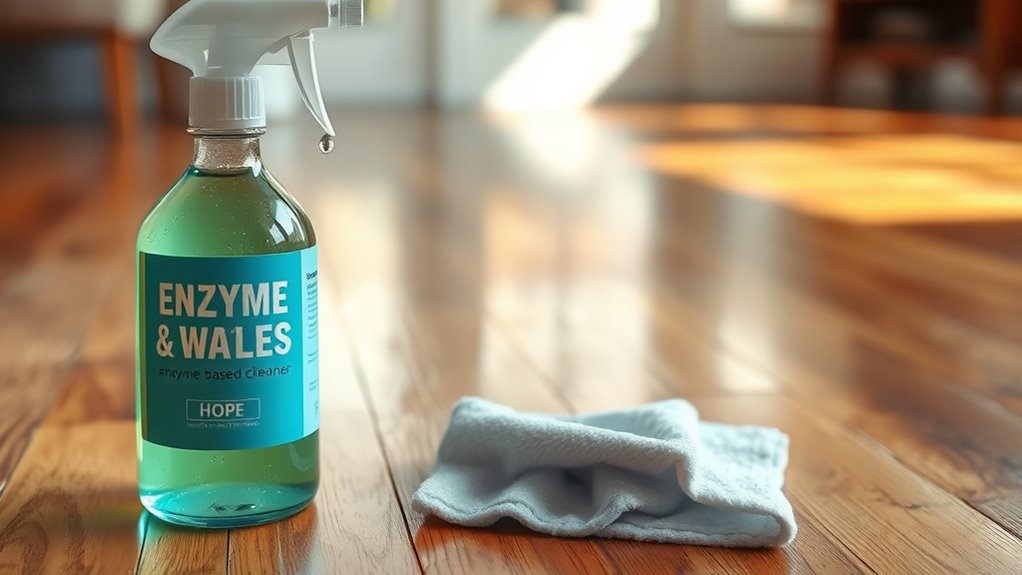
One effective way to eliminate urine odors and stains from wood floors is to apply an enzyme-based cleaner. This method targets organic matter through enzyme activation, boosting cleaning efficacy far beyond standard cleaners. To get the most out of your enzyme cleaner:
- Apply the solution evenly over the affected area, ensuring full coverage.
- Allow the cleaner to soak in for the recommended time to activate enzymes fully.
- Avoid scrubbing aggressively, as this may disrupt the enzyme action on urine compounds.
- Use a clean cloth to blot excess liquid without rinsing, preserving enzymatic activity.
Rinse and Dry the Floor Thoroughly
After applying the enzyme cleaner, you’ll need to rinse the wood floor carefully to remove any residue that could attract dirt or damage the finish. Choose gentle rinse methods—like a damp microfiber cloth or a mop wrung out with clean water—to avoid saturating the wood. Avoid harsh scrubbing; instead, work methodically to lift away leftover cleaner without harming the surface.
Once rinsed, use effective drying techniques to prevent moisture damage. Wipe the floor with a dry, absorbent towel or microfiber cloth immediately. Open windows or use fans to increase air circulation, speeding up drying while protecting your wood’s integrity. Proper rinsing and drying guarantee your floor remains clean and free from damage, giving you the freedom to enjoy your space without worry.
Neutralize Odors With Baking Soda
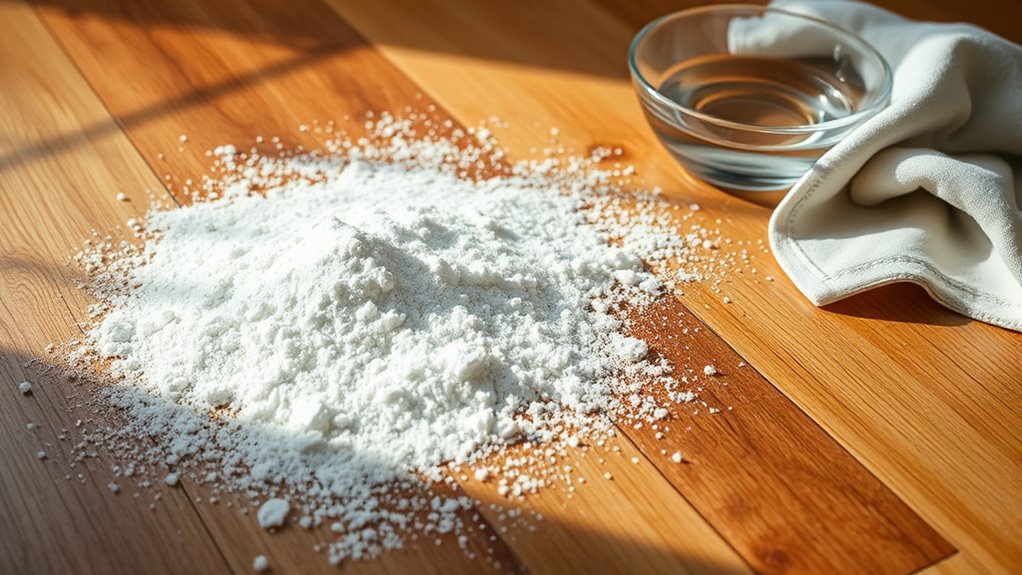
Though thorough cleaning removes most residues, lingering odors can still persist in your wood floors. Baking soda is a powerful ally for odor neutralization, thanks to its natural ability to absorb and eliminate smells without harsh chemicals. To harness baking soda benefits effectively, follow these steps:
- Sprinkle a generous layer of baking soda over the affected area.
- Let it sit for several hours or overnight to maximize absorption.
- Vacuum the baking soda thoroughly to remove trapped odors and moisture.
- Repeat if necessary for persistent smells.
This simple method grants you freedom from stubborn urine odors while preserving your floor’s integrity. Baking soda’s gentle yet effective properties make it the ideal choice for restoring freshness to your wood surfaces.
Polish and Protect the Wood Surface
While neutralizing odors is essential, you’ll also want to polish and protect your wood floor to restore its natural shine and guard against future damage. Start by choosing a polish suited for your floor’s finish—avoid wax-based products on polyurethane surfaces. Apply the polish evenly with a soft cloth or mop, following the grain of the wood to enhance its appearance. Once polished, consider applying a high-quality protective coating to strengthen the wood’s resistance to moisture and stains. Regular wood floor maintenance, including sweeping and promptly wiping spills, will prolong the coating’s effectiveness. By consistently polishing and sealing your floor, you guarantee durability and preserve the freedom to enjoy a clean, beautiful space without worry about recurring damage or odors.


